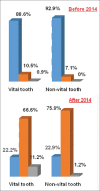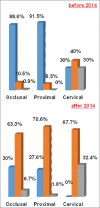Direct technique premolar coronal restorations: From metallic material to "complete adhesive restoration"
- PMID: 33088067
- PMCID: PMC7542080
- DOI: 10.4103/JCD.JCD_330_19
Direct technique premolar coronal restorations: From metallic material to "complete adhesive restoration"
Abstract
Introduction: The choice of restorative materials has for a long time been determined by the tooth position. Thus, premolar restoration depended on the practitioner's clinical assessment and practical experience in regard to the material to be handled.
Aim: The objective of this study was to assess, in the students' practice, the change in the choice of materials used for premolars restoration.
Materials and methods: This was a retrospective study based on the available care records in the department of conservative dentistry and endodontics of a dental school. Variables analyzed included the year of restoration, the type of material, the premolar position in the arch, and the coronal restoration site (occlusal, proximal, and cervical). Data collected were processed with the SPSS software version 22 (SPSS Inc., Chicago, IL, USA; 2013). The statistical significance threshold was set at 5% for Pearson's Chi-square test.
Results: Between 1994 and 2017, 1738 restored premolars were identified. Over the years, amalgam restorations declined from 99.2% in 1994 to 1.3% in 2017, contrary to composite whose frequency increased from 0.6% to 88.6%. Maxillary premolars were exclusively restored with composite in 2017 when amalgam was still, somewhat, used for mandibular premolars.
Conclusion: The reversal in the choice of materials in favor of composites reflects the global trend. This seems to be related to the current awareness of the prohibition, among others, of medical devices containing mercury.
Keywords: Amalgam; composite; glass ionomer cement; premolar restoration.
Copyright: © 2020 Journal of Conservative Dentistry.
Conflict of interest statement
There are no conflicts of interest.
Figures


 Number of restorations
Number of restorations
 Occlusal
Occlusal  Proximal
Proximal  Cervical
Cervical
 Amalgam
Amalgam  Composite
Composite  Glass Ionomer
Glass Ionomer
 Amalgam
Amalgam  Composite
Composite  Glass Ionomer
Glass Ionomer
 Amalgam
Amalgam  Composite
Composite  Glass Ionomer
Glass Ionomer
 Amalgam
Amalgam  Composite
Composite  Glass Ionomer
Glass Ionomer
 Amalgam
Amalgam  Composite
Composite  Glass Ionomer
Glass Ionomer
 Amalgam
Amalgam  Composite
Composite  Glass Ionomer
Glass Ionomer
 Amalgam
Amalgam  Composite
Composite  Glass ionomer
Glass ionomerReferences
-
- Hickel R, Dasch W, Janda R, Tyas M, Anusavice K. New direct restorative materials. FDI commission project. Int Dent J. 1998;48:3–16. - PubMed
-
- de Souza Costa CA, Hebling J, Scheffel DL, Soares DG, Basso FG, Ribeiro AP. Methods to evaluate and strategies to improve the biocompatibility of dental materials and operative techniques. Dent Mater. 2014;30:769–84. - PubMed
-
- McDevitt WE, Warreth AA. Occlusal contacts in maximum intercuspation in normal dentitions. J Oral Rehabil. 1997;24:725–34. - PubMed
-
- Xu H, Han X, Wang Y, Shu R, Jing Y, Tian Y, et al. Effect of buccolingual inclinations of maxillary canines and premolars on perceived smile attractiveness. Am J Orthod Dentofacial Orthop. 2015;147:182–9. - PubMed
-
- Denloye OO, Ajayi DM, Popoola BO. Dental caries prevalence and bilateral occurrence in premolars and molars of adolescent school children in Ibadan, Nigeria. Odontostomatol Trop. 2015;38:46–50. - PubMed
LinkOut - more resources
Full Text Sources
